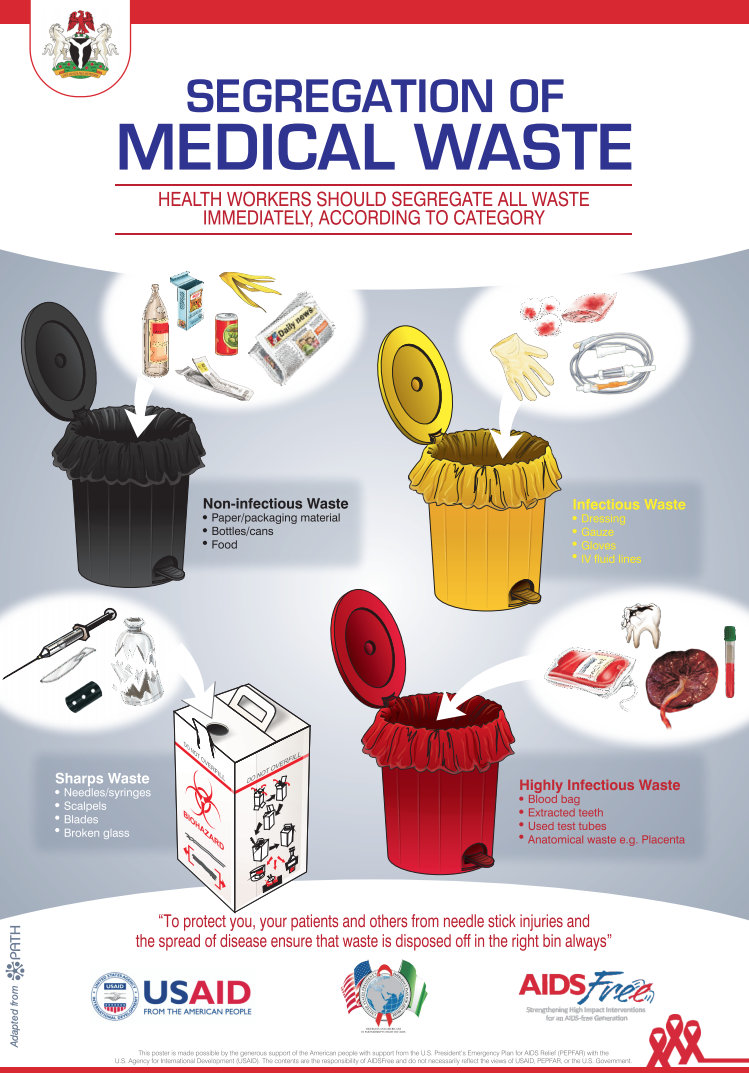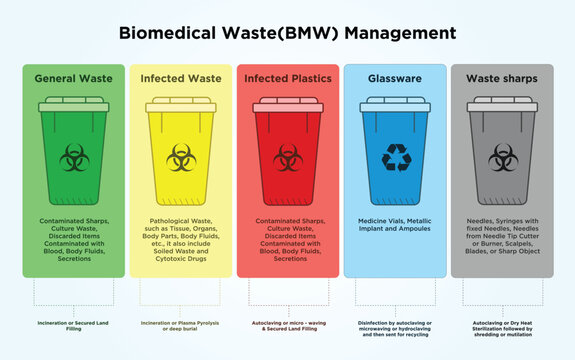Efficient and Accountable Medical Waste Removal: Protecting Individuals and the Planet
Wiki Article
Best Practices for Medical Waste Management
Medical waste management is a crucial aspect of health care centers' operations to make sure the security of individuals, personnel, and the atmosphere. Applying best methods in medical waste management is crucial to reduce the dangers linked with hazardous waste.
Partition and Classification
In the area of medical waste administration, proper partition and classification are crucial practices for ensuring the reliable and secure disposal of healthcare-related products. Medical waste is produced from numerous resources, including health centers, facilities, labs, and other medical care facilities. It contains a vast array of things, such as needles, syringes, plasters, handwear covers, and pharmaceutical waste.Segregation includes the organized separation of different kinds of medical waste based on their features and possible threats. Sharps waste, such as needles and blades, must be positioned in puncture-resistant containers to avoid injuries and the spread of contagious conditions.
Classification is the procedure of categorizing medical waste right into various groups based upon its potential risks. These classifications might consist of contagious waste, hazardous waste, pharmaceutical waste, and general waste. By categorizing waste, medical care centers can determine the appropriate disposal approaches and ensure conformity with regional guidelines and standards.
Proper partition and classification of medical waste not just shield the health and wellness of healthcare employees and the general public yet additionally add to the total efficiency and performance of waste administration. It decreases the threat of crashes, reduces environmental impacts, and promotes responsible garbage disposal practices.
Proper Storage Space and Labeling
To guarantee the safe and effective disposal of medical waste, health care centers must comply with appropriate storage and labeling techniques. WasteX Medical Waste Disposal. Proper storage space and labeling play a critical duty in maintaining the integrity of medical waste administration systems and shielding the health and wellness of medical care workers, patients, and the publicWhen it pertains to storage space, it is vital to have assigned locations specifically designed for various kinds of medical waste. These areas need to be protected, well-ventilated, and equipped with suitable containers that fulfill governing requirements (medical waste disposal service). Segregation and classification of waste ought to also be taken into account to stay clear of cross-contamination and prospective risks

Routine monitoring and inspection of storage locations and containers are necessary to recognize any kind of problems or violations. Team needs to be trained on appropriate storage space and labeling methods, emphasizing the significance of compliance with procedures and laws.
Safe Transportation and Handling
Making sure the protected and appropriate transport and handling of clinical waste is critical for keeping the stability of waste monitoring systems and securing the health and security of all involved. Medical waste, that includes products polluted with infectious materials, drugs, and other dangerous substances, should be transported in a manner that protects against leaks, spills, and prospective contamination.To achieve risk-free transport and handling, several ideal practices ought to be complied with. First, it is important to make use of leak-proof and puncture-resistant containers that are particularly made for medical waste. These containers need to be appropriately sealed and identified to prevent any kind of unintended direct exposure or messing up. Additionally, waste needs to be segregated based upon its nature and kind to stop cross-contamination.
During transportation, it is necessary to make certain that waste containers are safely fastened and stored in a secure manner. Autos made use of for moving clinical waste must be furnished with appropriate safety and security functions, such as spill containment systems, to decrease the threat of any spills or leaks. Motorists ought to get training on appropriate handling and emergency action treatments to effectively resolve any type of unforeseen cases.
Additionally, the transportation and handling of medical waste need to abide by all pertinent policies and standards set forth by regional, state, and government authorities. WasteX Medical Waste Disposal. medical waste disposal service. Normal evaluations and audits ought to be conducted to evaluate compliance and recognize any type of locations for renovation
Conformity With Regulatory Standards
Maintaining conformity with governing standards is essential for effective clinical waste monitoring. These standards are placed in location to secure public health and the environment by ensuring that clinical waste is correctly taken care of, treated, and disposed of. Conformity with regulative standards assists to stop the spread of contagious illness, decrease possible threats, and lower the total influence of clinical waste on the setting.To achieve conformity, healthcare facilities should stay informed about the specific guidelines controling clinical waste administration in their territory. These laws might differ from country to nation, and even within different states or areas. It is necessary for healthcare facilities to have a thorough understanding of these standards and to apply suitable techniques and protocols to make certain compliance.
One key aspect of compliance is the correct partition and labeling of different kinds of medical waste. This includes separating sharps from various other waste, in addition to categorizing waste based upon its potential dangers. Healthcare facilities should additionally guarantee that clinical waste is saved in appropriate containers which these containers are correctly classified and sealed.
Furthermore, conformity with governing guidelines calls for medical care facilities to establish correct training and education programs for staff participants associated with clinical waste administration. This consists of providing training on waste partition, managing, and disposal procedures, along with the appropriate use personal safety tools.
Normal tracking and audits are additionally vital to make certain recurring compliance with governing guidelines. This includes performing normal inspections of waste storage locations, documenting waste monitoring treatments, and keeping records of garbage disposal.
Reliable Disposal Techniques
Medical care facilities need to utilize reliable disposal approaches for correct administration of clinical waste. Incorrect disposal of clinical waste can pose serious wellness and environmental dangers. There are numerous techniques that can be utilized to effectively get rid of medical waste, making sure the security of medical care workers, patients, and the basic public.One frequently utilized approach is incineration. Incinerators can safely burn clinical waste at high temperatures, lowering the volume and damaging any type of potentially damaging microorganisms. Incineration can be expensive and may release hazardous toxins right into the air if not appropriately regulated.
One more technique is autoclaving, which includes subjecting the waste to high-pressure heavy steam. This procedure kills bacteria, infections, and various other microbes, making the waste safe for disposal in routine waste streams. Autoclaving is a effective and eco friendly technique, but it needs specialized equipment and skilled personnel.
Chemical disinfection is also made use of sometimes, where liquid chemicals are used to the waste to sanitize it. This method is less frequently made use of as a result of worries about the efficiency of chemical disinfection and the possibility for chemical deposits to pollute the environment.
In enhancement to these techniques, health care centers must likewise implement appropriate segregation, product packaging, and labeling of medical waste to ensure its risk-free handling and disposal. Regular training and education of team on appropriate waste administration techniques are vital to maintaining effective disposal techniques.
Verdict
In final thought, applying finest methods for clinical waste monitoring is essential for making certain the security of health care workers, patients, and the atmosphere. By correctly segregating and classifying waste, keeping and identifying it properly, ensuring risk-free transport and handling, abiding by regulatory standards, and using effective disposal approaches, medical care Visit This Link centers can properly manage and minimize the dangers connected with clinical waste. It is critical for medical care companies to stick and prioritize to these finest methods to keep a sustainable and risk-free medical care environment.Clinical waste administration is a crucial element of medical care facilities' procedures to guarantee the security of patients, staff, and the setting. Implementing ideal practices in clinical waste administration is important to lessen the dangers connected with harmful waste. These groups may consist of contagious waste, hazardous waste, pharmaceutical waste, and general waste.In final thought, executing best techniques for clinical waste administration is vital for ensuring the security of healthcare employees, patients, and the setting. By effectively segregating and classifying waste, saving and labeling it correctly, making sure secure transportation and handling, complying with regulatory guidelines, and utilizing reliable disposal techniques, healthcare centers can successfully handle and lessen the risks connected with medical waste.
Report this wiki page